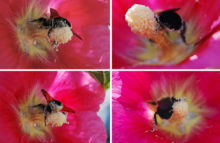| Study nesting box for wild solitary bees |
Something special arrived in our back yard on Earth Day 2011: a nesting box for wild cavity-nesting solitary bees such as mason (Osmia) and leaf-cutter bees (Megachile). It’s one of 220 scat
tered in private and public spaces, including green roofs, around the city, as part of a York University study of Toronto’s wild bee population. In fact, though, 15 North American cities all tolled will be participating.
Today, a most earthily appropriate day, PhD candidate, Scott MacIvor, came to our garden to install my bee hotel in a sunny-ish spot. It’s close to our cedar shed, where we’ve hosted carpenter bees (Xylocopa) companionably for many seasons*.
So, we’ll watch to see who sets up house before Scott returns to pick up and study the residents come fall (and set them free again next spring). I haven’t seen any mason bees around before, but have seen evidence of leaf-cutter bees. Both types nest in existing cavities such as the hollow stems of plants, which the tubes in the bee box mimic. Hope they all come to roost.
 |
| Scott installs my nesting box |
By coincidence, I’ve also received a sample of another bee nest box from Armstrong & Blackberry Horticultural Products, which I will also be installing – the more the merrier, according to Scott. This box kit comes with plastic disks t
o cover the tunnel openings to keep out parasites; after pesticides, the biggest threat to the bees’ survival. As York’s quota of free bee nests for the study is full, buy your own bee box through the link above.
You might like to. Solitary bees are not stinging bees unless very frightened (such as if you clutched one in your hand), and they’re vitally important as pollinators, more so than honeybees for some food crops. Tomato flowers, for instance, need to be vibrated at bumblebee-type frequencies in order to release their pollen, fertilize the flower and make fruit. If you want tomatoes you need buzzing solitary bees.
*As an aside on carpenter bees: While I’m a bee-leaver, I’ve spoken to a few who are less than enamoured. Carpenter bees, unlike masons and leaf-cutters, drill tunnels as nests. Less problematic in temperate climates, where cold winters keep populations down, in a microclimate here, or in warmer climes, large populations of nesting carpenter bees can structurally weaken the wood where they nest.
While carpenter bees do not live in colonies, they do return to nest in their birthplace. If they can’t use the tunnel where they were born (they’ll sometimes fight over this), they’ll drill another nearby. This aggregation of solitary tunnels can seem like a colony. If you have many carpenter bee holes in your deck, you might not particularly care whether it’s a colony or not.
A twofold solution is a) to paint the untreated wood and repaint it regularly, and b) to install a block of unpainted, untreated wood, on a stake, such as weathered cedar (note my shed) that the bees might prefer – then to move it to a field in late fall, so that will the birthplace they return to. Note that they’d rather reuse existing tunnels, as tunnelling is hard work. So filling up their old holes actually encourages them to drill a new one.
Carpenter bees are excellent pollinators. Let’s try to live with them, Earth Day and every day.





4 comments
If I were a bee, I'd rather live in your shed than in a mobile hotel and be carted off to be studied.
Esther
Bother, I meant to say HAPPY EASTER!
There, now I've said it!
Esther
Great idea… I might just make something similar..
Happy Easter to you, too, Esther. Easter, Esther. Esther, Easter. That's quite a tongue-twister!
Bangchik and Kakdah, I've seen home-made solitary bee nests made from off-cuts of old hose or bamboo stakes, set in a frame. Give it a try.